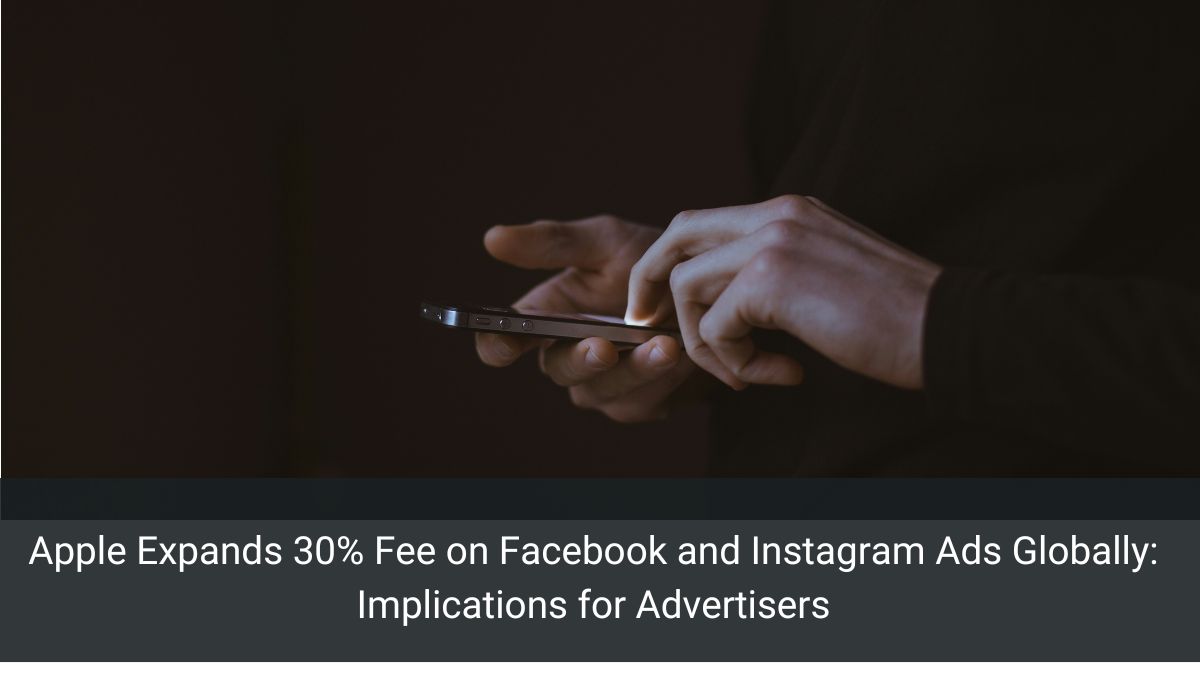Ad Tech
Apple Expands 30% Fee on Facebook and Instagram Ads Globally: Implications for Advertisers

Starting July 1, Apple will extend its 30% fee on Facebook and Instagram ad purchases made through iOS devices to advertisers worldwide. This move, initially implemented for U.S. advertisers in February, signifies a substantial shift in mobile advertising dynamics. In this article, we will explore the details of this expansion, its implications for businesses, the ongoing legal and competitive disputes, and potential strategies for advertisers to navigate these changes.
The Expansion of Apple’s 30% Fee
Background and Initial Implementation
Apple’s 30% fee on in-app purchases, often referred to as the “Apple Tax,” has been a contentious issue for years. Initially, this fee applied primarily to app purchases and in-app transactions. However, in February, Apple extended this fee to cover Facebook and Instagram ad purchases made through their iOS apps. This decision has now been expanded to advertisers globally, marking a significant escalation in Apple’s app store policies.
The Global Rollout
From July 1, advertisers worldwide will face this 30% fee on ad purchases made through iOS devices. This expansion means that businesses of all sizes, regardless of location, will need to account for this additional cost in their advertising budgets. The fee applies specifically to ad purchases made within the iOS apps of Facebook and Instagram, but it can be avoided by using desktop web browsers.
Implications for Advertisers
Increased Advertising Costs
The most immediate impact of this expansion is the increase in advertising costs for businesses. A 30% fee is substantial and could significantly affect the return on investment (ROI) for ad campaigns. Smaller businesses and startups, which often rely heavily on cost-effective digital advertising, may find it challenging to absorb these additional costs.
Shifts in Advertising Strategies
To mitigate the impact of the fee, advertisers may need to rethink their strategies. One potential approach is to shift more advertising activities to desktop platforms, where the fee does not apply. Meta, the parent company of Facebook and Instagram, has updated its web platforms to offer the same ad-boosting functionality available on mobile apps, providing a viable alternative for advertisers looking to avoid the fee.
Legal and Competitive Landscape
Criticism and Legal Challenges
Apple’s fee structure has faced significant criticism and legal challenges from various quarters. EU regulators and a U.S. federal judge have criticized the fee as being anti-competitive. According to Pedro Pavón, Meta’s Director of Privacy & Fairness Policy, the fee gives Apple an unfair advantage. These criticisms highlight the broader concerns about the monopolistic practices of tech giants and their impact on competition.
Apple’s Defense
Apple contends that it is entitled to charge for access to its platform’s audience. The company argues that its App Store policies are designed to ensure a secure and high-quality user experience. However, this justification has not quelled the ongoing debates and legal battles over the fairness and competitiveness of these fees.
Navigating the New Advertising Landscape
Adapting Strategies
Advertisers will need to adapt their purchasing strategies to avoid the 30% fee. Shifting ad purchases to desktop platforms is one way to circumvent the fee. Additionally, businesses may need to reallocate their budgets and adjust their campaign strategies to maintain their ROI. This might involve a greater emphasis on multi-channel marketing and leveraging platforms that do not impose similar fees.
Meta’s Guidance
Meta has provided guidance to help advertisers navigate these changes. By utilizing Meta’s updated web platforms, advertisers can access the same ad-boosting functionality without incurring Apple’s 30% charge. This approach allows businesses to continue leveraging Facebook and Instagram’s powerful advertising tools while avoiding the additional costs imposed by Apple.
Broader Implications for the Industry
Intensifying Scrutiny of Apple’s Policies
Apple’s expansion of the 30% fee is likely to intensify scrutiny of its App Store policies. As regulators and legal bodies examine the fairness and competitiveness of these fees, the tech industry may see increased calls for regulatory reforms. These developments could lead to changes in how app stores operate and how fees are imposed on in-app purchases.
Impact on Mobile Advertising Practices
The introduction of this fee may reshape mobile advertising practices. Advertisers may become more cautious about relying solely on mobile platforms for their campaigns. Instead, they may adopt a more diversified approach, balancing mobile and desktop advertising to optimize their costs and reach.
Personal Reflections and Industry Perspectives
A Personal Encounter with Increased Costs
As a digital marketer, I’ve seen firsthand how unexpected costs can impact campaign strategies. A few years ago, a sudden increase in platform fees forced my team to rethink our entire budget allocation. We had to pivot quickly, moving a significant portion of our ad spend to alternative platforms to maintain our ROI. This experience underscored the importance of flexibility and adaptability in digital marketing.
Industry Voices
Many industry professionals share concerns about the impact of Apple’s fee on advertising budgets. Smaller businesses, in particular, may struggle to cope with the increased costs. However, some also see this as an opportunity to innovate and explore new advertising channels. By diversifying their strategies, businesses can reduce their dependency on any single platform and mitigate the risks associated with sudden policy changes.
Apple’s expansion of its 30% fee on Facebook and Instagram ads globally marks a significant shift in the digital advertising landscape. This move will likely increase advertising costs and force businesses to adapt their strategies. While the fee has been criticized as anti-competitive, Apple maintains that it is justified in charging for access to its platform’s audience.
Advertisers must navigate these changes by exploring alternative platforms and strategies to avoid the fee. As the industry grapples with these developments, the broader implications for app store policies and mobile advertising practices will continue to unfold.
In conclusion, the expansion of Apple’s 30% fee underscores the need for flexibility and innovation in digital marketing. By staying informed and adaptable, businesses can successfully navigate this evolving landscape and continue to achieve their advertising goals.
